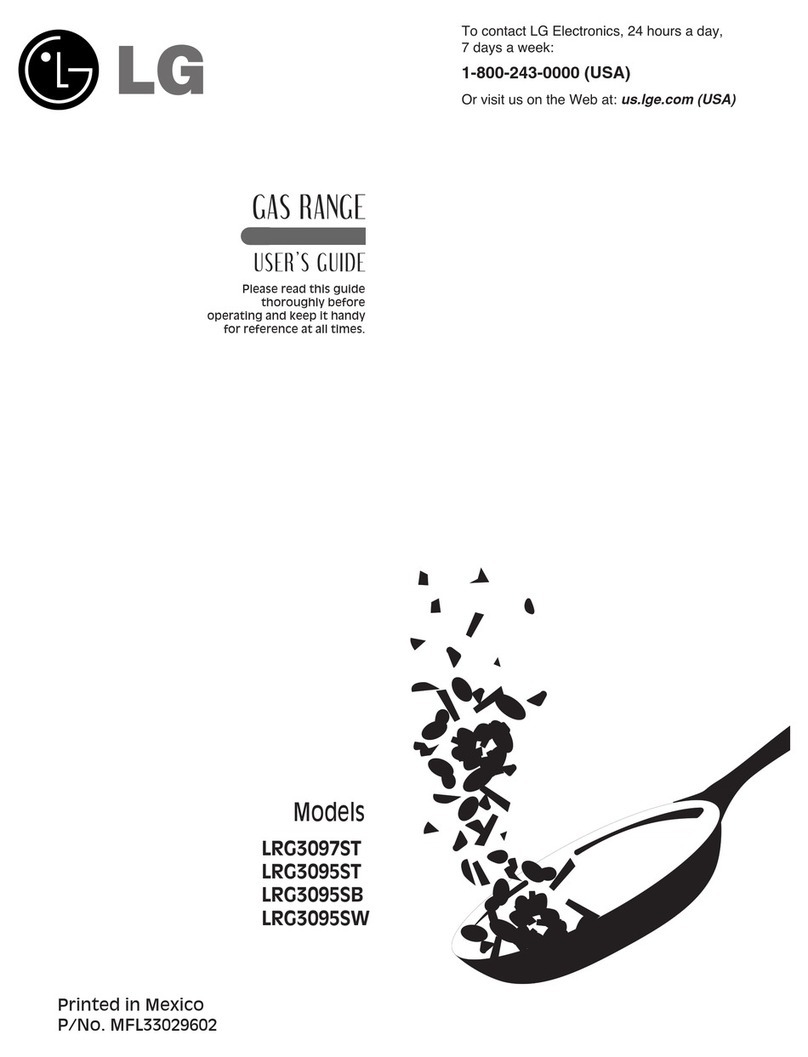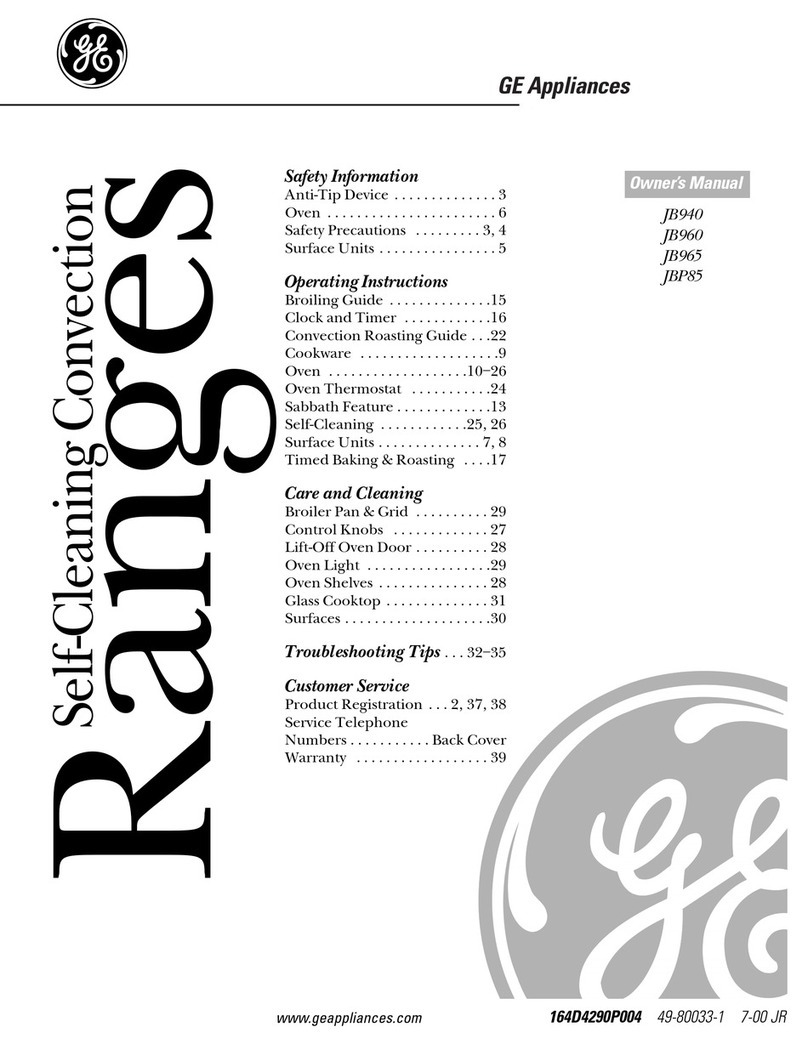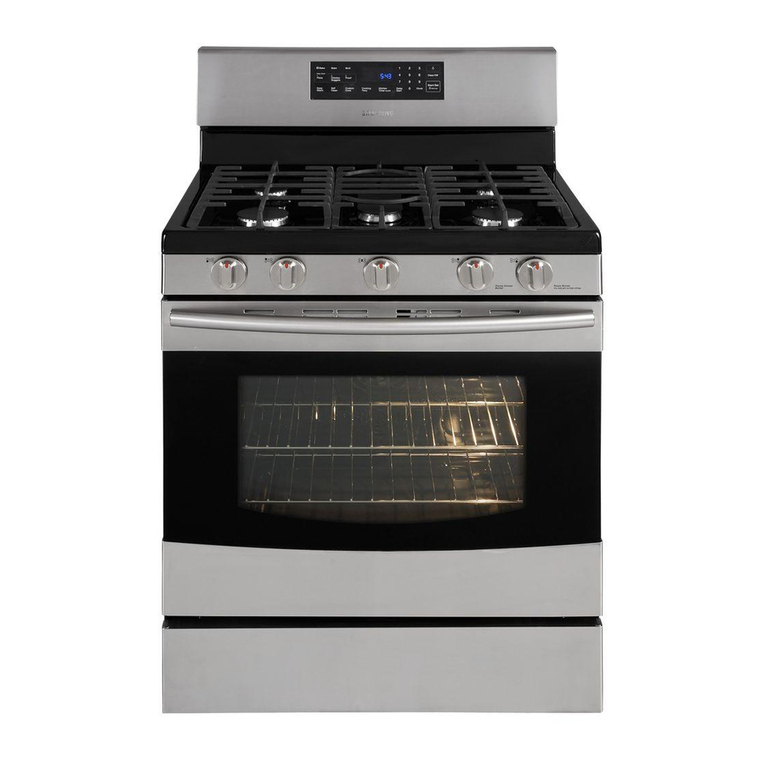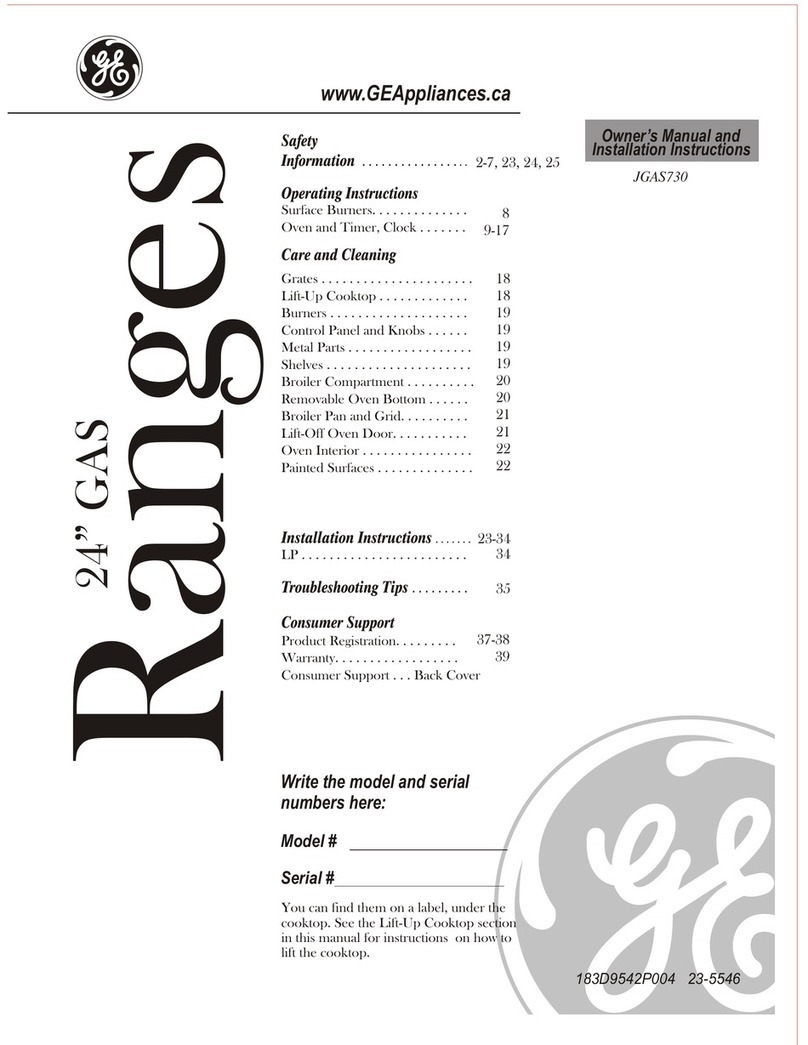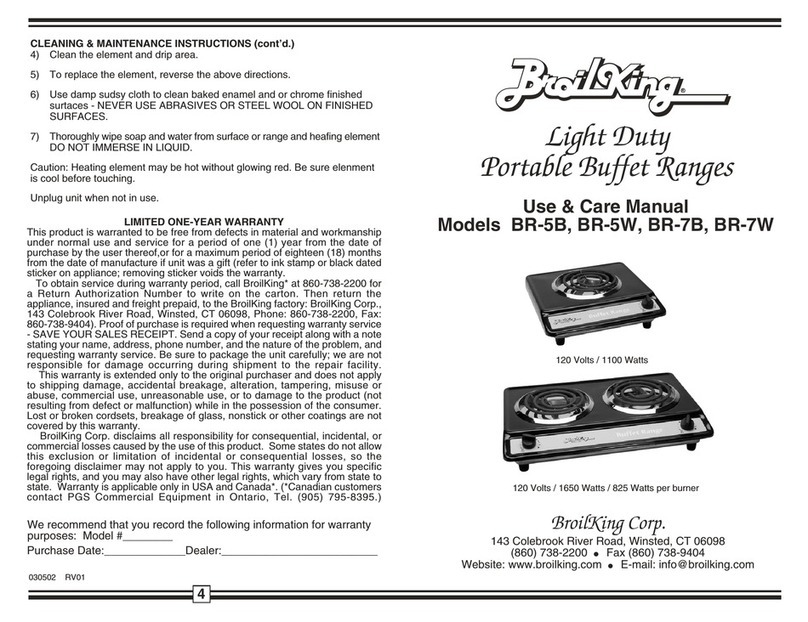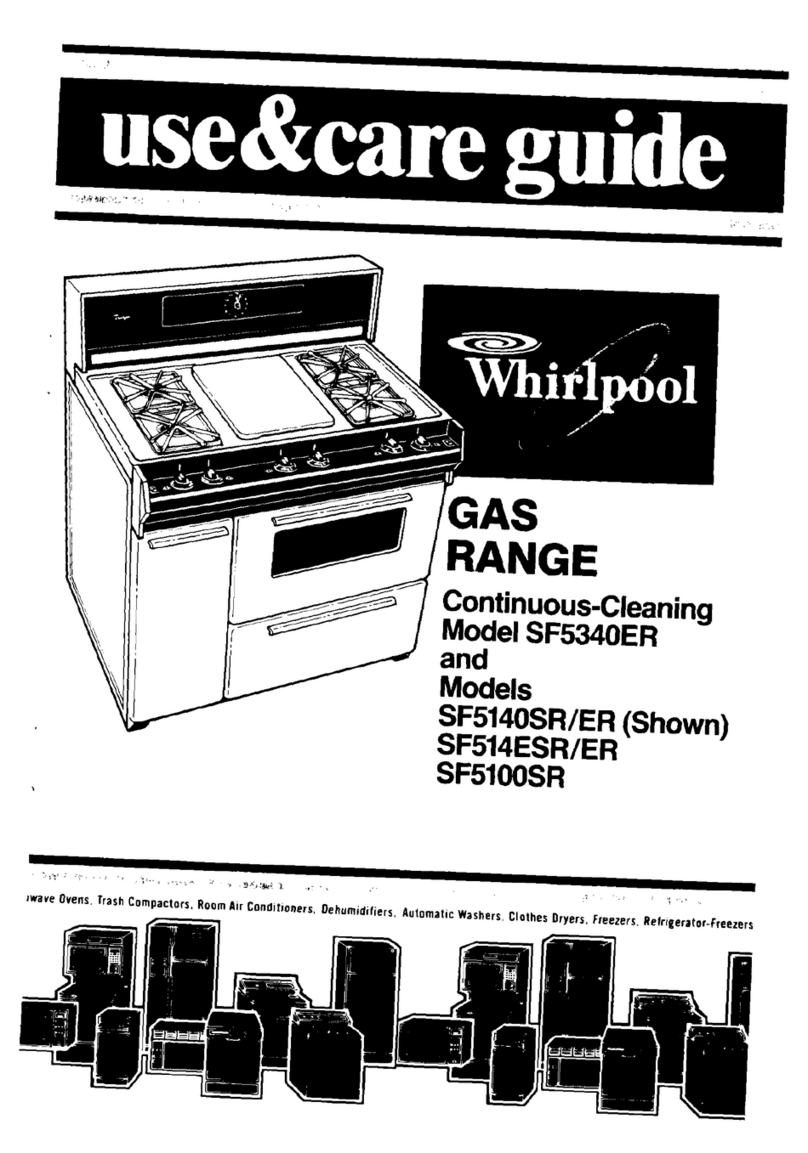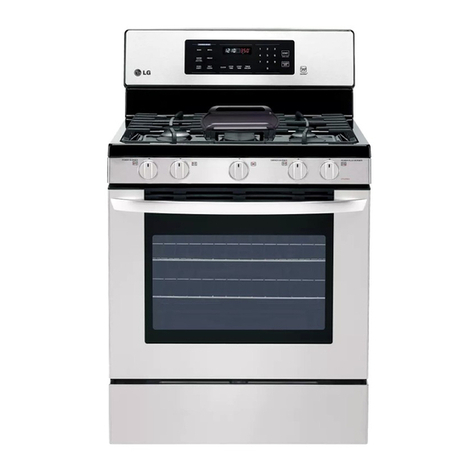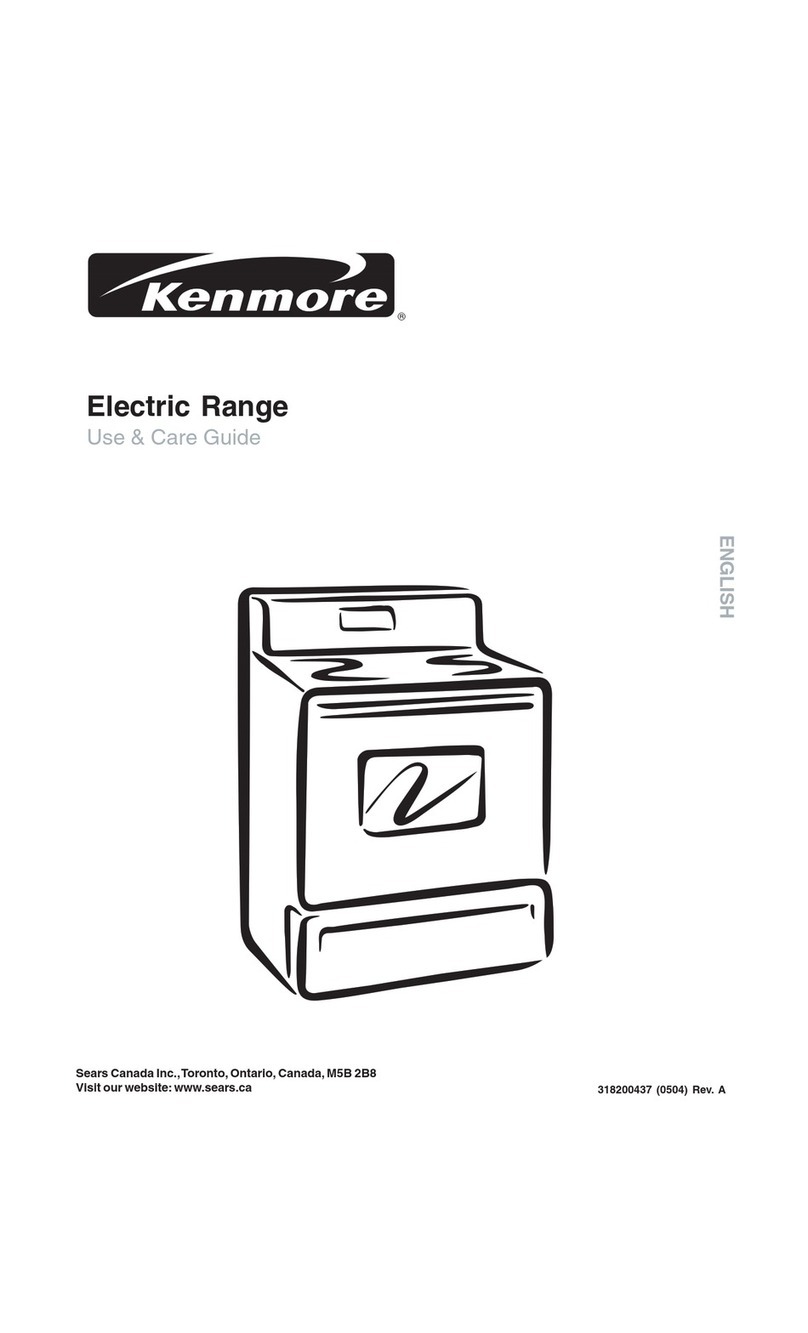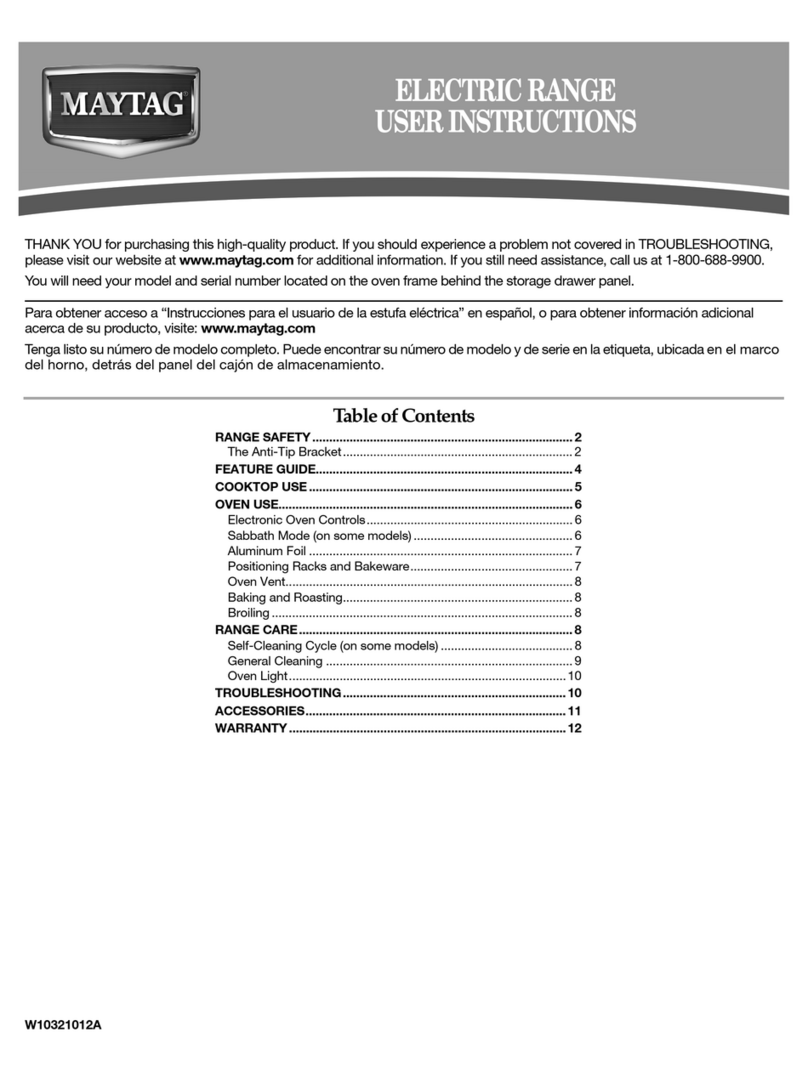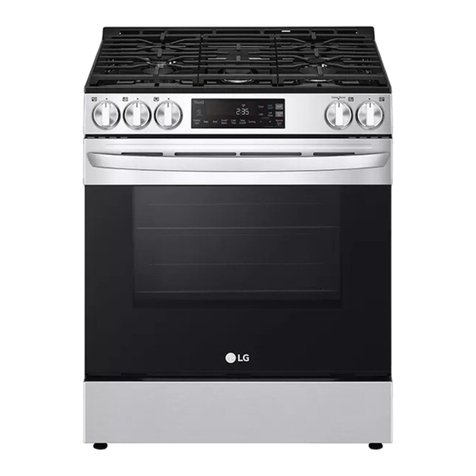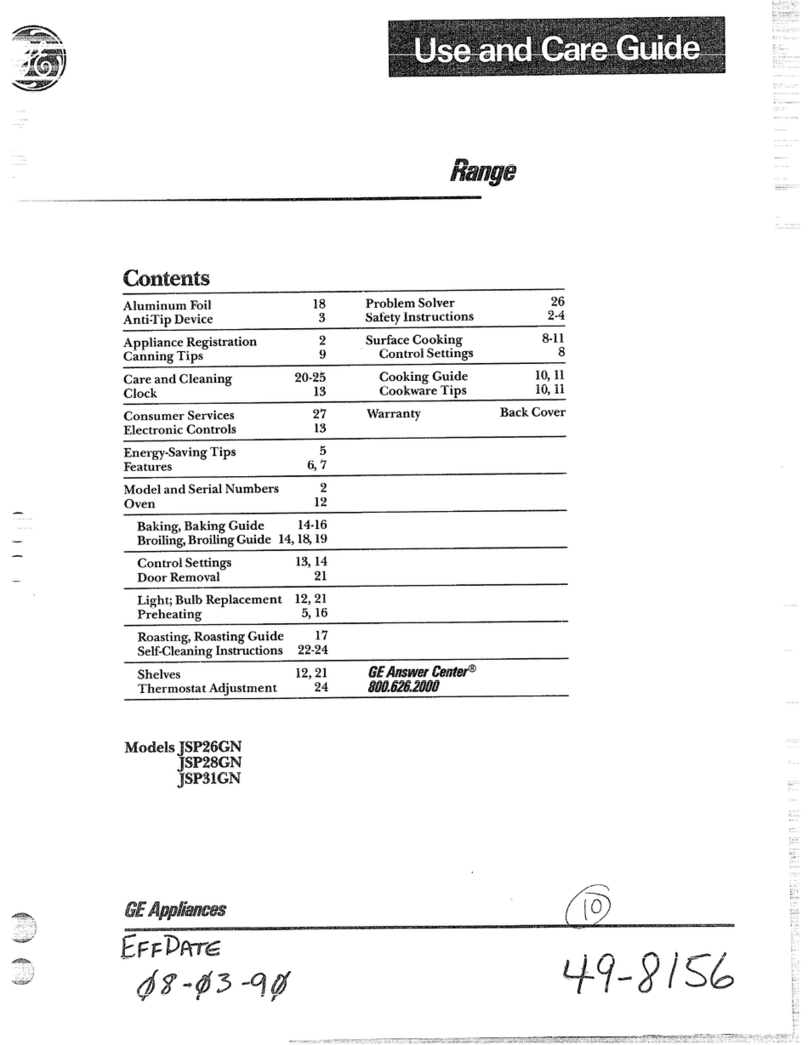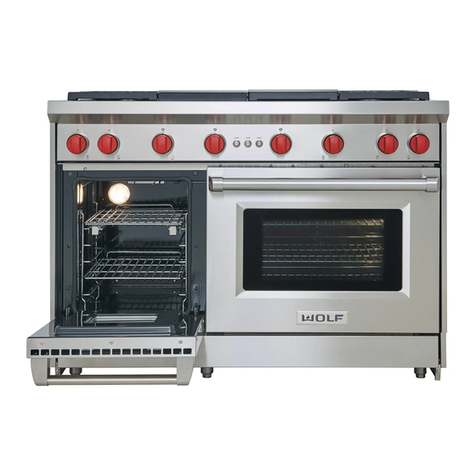Chef's Choice PetitePie Maker Quick guide

PetitePie™Maker
Instructions & Recipes for Model 860
Instructions et recettes pour le modèle 860
© 2014 EdgeCraft Corp.
International
GB F

2
IMPORTANT SAFEGUARDS
Basic safety precautions should always be followed when using electrical appliances
including the following:
1. Read all instructions before using the PetitePie™ Maker Model 860.
2. Do not touch hot surfaces.
3. Always use plastic handle on lid and do not touch stainless cover or the
cooking plates when hot.
4. To protect against fire, electric shock and injury to persons, do not immerse
cord, plug or pie maker in water or other liquid.
5. Close supervision is necessary when any appliance is used by or near children.
6. Before use, unwind the power cord completely and keep the cord away from
hot parts of the appliance.
7. Do not let power cord hang over edge of table or counter or touch hot surfaces.
8. Do not place on or near hot gas or electric burner, or in a heated oven.
9. Extreme caution must be used when moving an appliance containing hot oil or
other hot liquids.
10.Only operate the pie maker on a dry, flat, non-slip surface.
11.Do not use the PetitePie™ Maker outdoors.
12.Do not operate the PetitePie™ Maker with a damaged cord or plug. If it
malfunctions or has been damaged in any manner, return the PetitePie™ Maker
to the EdgeCraft Corporation Service Department for examination, repair or
adjustment.
13.The use of accessory attachments not recommended by the EdgeCraft
Corporation may result in fire, electric shock or injury to persons.
14.Always unplug the pie maker from electrical outlet when not in use and before
cleaning, to avoid accidental electrical shock.
15.Allow to cool before cleaning and storing.
16.As long as the appliance is hot, even if unplugged, there is the danger of
someone getting burned. Do not touch hot surfaces and do not put it into
storage while hot.
17.Do not use the PetitePie™ Maker for other than intended use.
18.For use only on 120V 60HZ power. Use a socket with a good
ground connection.
19.Do not use harsh abrasives, caustic cleaners when cleaning the appliance.
20.For household use only.
21. SAVE THESE INSTRUCTIONS.

3
YOU MADE
A GOOD
CHOICE
The PetitePie™Maker Model 860 comes to you from
Chef’sChoice®,the maker of the world’s finest professional
household gourmet products. The PetitePie™Maker is not
only for special occasions. The PetitePie™Maker brings to
your home the capabilities of making treats for breakfast,
lunch, dinner and dessert. Individual quiches, muffins and
both savory and sweet pies can be ready in minutes. You
may bake pies from scratch or use convenient short cuts
for that home baked flavor.

4
GETTING TO KNOW YOUR PetitePie™Maker
It will take only a minute to get to know your PetitePie™Maker Model 860. You will see that it is
made of high strength, durable quality, high temperature engineering plastic, cast aluminum plates
and a brushed stainless steel lid.
To open the lid, squeeze the front plastic handle with its locking latch together and lift.This will expose
the baking plate surfaces.
The non-stick surfaces of the Model 860 are coated with the world’s most advanced non-stick
technology.You will be impressed to see how easily even your stickiest pies, cakes or biscuits can be
lifted off the plates. In most cases, cleanup is as easy as wiping out the pie maker with a soft cloth.
There is no power switch. The baking plates are energized as soon as the power cord is inserted into
a three (3) prong 120 Volt A.C. outlet. Once plugged in the red baking light will illuminate immediately
to let you know the Model 860 is “ON”. The red light (see Figure 1) will stay lit as long as the unit is
plugged in, indicating there is power to the unit. In about 4 minutes the plates will be heated and the
green light will come on indicating the unit has come to the proper baking temperature. The green
light will cycle on and off maintaining the proper bake temperature. When the green light is on the
unit is at the proper baking temperature. Heating will resume automatically and the green light will
go out whenever the plates need power to maintain a uniform temperature.The green light will come
back on when the plates have once again reached the proper temperature. The green baking light
will continue to cycle on and off as you bake, reassuring you that the proper baking temperature is
being maintained.
There is a convenient timer (see Figure 2a) built into the PetitePie™Maker. Follow the recipe’s timing
instructions. The timer may be adjusted to your individual needs.Times will vary based on the type of
food being baked.Set the time your pies need to bake by using the up and down arrows (see Figure 2a).
Figure 1.
Handle for Lid
Red Baking Light
Control Panel
(see Figure 2a)
Locking Latch
Green “Ready to
Bake” light

5
To increase the time, press the up arrow.To decrease the time, press the down arrow.You may quickly
increase or decrease the time by pressing the up or down arrow and holding it in until the desired
setting is reached.To clear the times press both arrows at the same time. Once you have set the time
you need for your recipe press the Start button and the timer will start counting down. You will hear
the PetitePie™Maker beep seven times when your pies are ready. The beeper will sound again after
a minute if no one has attended to the pies. The pie maker is programmed to remember how long
you set the time for. With a little experience you will achieve perfect pies, cakes, muffins and quiches
every time.
Please note that baking continues after the timer beeps.The timer does not control the heating elements.
Included with the PetitePie™Maker is a two sided pastry cutter and a pusher (see Figure 2b). The
large side of the cutter should be used for cutting the bottom pie shell and the smaller side should
be used for cutting out the tops or for opened faced crusts, such as used in tarts. The pusher can be
used to gently depress the bottom crust into the pie form.
For your safety when baking, open the lid very carefully.
Provisions have been made for cord storage on the bottom of the unit.
USING THE PetitePie™Maker FOR THE FIRST TIME
Insert the PetitePie™Maker power cord into a grounded 120 volt outlet and close the cover. The red
“baking” light will turn on immediately indicating there is power to the unit and the plates are heating.
In about 4 minutes the green light will come on indicating the PetitePie™Maker is ready for baking.
On the first heating you may sense a slight odor during the heat-up cycle. This is typical of new
heating elements. Because both of the baking surfaces are factory finished with an extremely effective
non-stick coating, it is unnecessary to oil the surfaces before you use the PetitePie™Maker.
Figure 2a. Control Panel.
Precise Digital Timer
Start TimerSet Time
Figure 2b.
Pastry Cutter
Pastry Pusher

6
GENERAL INSTRUCTIONS FOR PIES AND TARTS
1. Plug in the pie maker and Preheat as described previously.
2. While the PetitePie™Maker is preheating, prepare the crust. Unroll premade pie crust on a
lightly floured surface or roll out homemade dough to a flat sheet of desired thickness.
3. Cut out the pie bottoms and tops (if needed) using the supplied cutter. The included pie cutter
has a large and small cutter conveniently molded into one piece. Use the larger circle for the
bottom crusts and the smaller circle for the top crusts.Apply light pressure with fingers inside
the top lip of the pie cutter to cut through the pastry (Figure 3a). Pressing on the cutter with a
flattened hand is not recommended as the top edges of the cutter can cause discomfort to the
hand (Figure 3b).
4. Prepare the pie filling. The pie filling will need to be spooned into the crusts immediately after
the crusts are placed into the pie maker. Fillings can range from sweet to savory and you can
bake double or single crusted pies.
5. Making sure that the green “ready” light is illuminated, place one pie base into one of the pie
cavities, taking care to center the dough in the cavity. Then use the pusher to press the dough
so that it is in full contact with the baking plate (Figure 3c).
6. Spoon the pre-cooked pie filling into the base. For covered pies, use a rounded ½ cup of filling.
for un-covered pies and tarts, fill the pastry shell approximately 2/3full.
7. For covered pies, place a pie pastry cover (small circle) over the filled pie, being careful to
center the dough. It is recommended to pierce the cover in a few small places to allow steam to
escape during cooking.
8. Repeat steps 5-7 to make pies in the remaining three cavities. It is recommended to cook in full
batches of four for even cooking and consistent thermostat operation.
9. Close the lid firmly so that the latch clicks into the locked position.
10. Set the timer for the time recommended by the specific recipe.
11. When the timer beeps, check the pies.The pies should be golden brown when fully baked. If the
color of the pies is too light, close the lid and continue baking for another minute or two. If the
pies are too dark, reduce the cooking time by a minute or two for the next batch of pies. Keep
hands away from the hot stainless cover and baking surfaces. Touch only the plastic parts and
handle provided.
12. When the pies are done they can be removed easily by lifting one edge with a heat-resistant
plastic fork and sliding a flat spatula under the pie to lift and transfer it to a cooling rack.
(If you use a metal fork, use care not to contact cooking surfaces since that might scratch the
non-stick surface and decrease its effectiveness.)
Figure 3a. Figure 3b. Figure 3c.

7
13. After removal of the pies, the PetitePie™Maker can be immediately refilled with a new set of
crusts and fillings or it can be closed until you are ready to bake again.
14. When finished baking, be certain to unplug the PetitePie™Maker. Only then is the unit no longer
powered. Always unplug the PetitePie™Maker immediately after use. Never leave it unattended
when plugged in. Children should not be allowed to use the pie maker except in the presence
of an attentive adult. The PetitePie™Maker cools faster when its lid is left fully open. Store only
when cold.
SUGGESTIONS
• Usehomemadeorstoreboughtpiedoughfordoublecrustedorsinglecrustedpiesandquiches.
• Alwaysusepre-cookedllingsforpies.Thecookingtimeforpiesisnotsufcientforcooking
raw meats. Fillings should also be cooled to room temperature before adding to the pie maker.
• Generally,formakingcoveredpies,llthepieshellsbyusing½cupoflling.Avoidputtingtoo
much filling in the pie forms as that will cause an overflow and increase the clean up time. Too
little filling will result in an underdone uneven top crust. With practice you will know how full
the crusts should be so that the top plates cook the top crusts evenly. Close the lid immediately
after adding the pie crust and filling. Press down lightly on the lid handle as it is closed and snap
it shut. Set the timer according to the recipe directions, and press the “Start” button.
• UseyourPetitePieMakerforbreakfastlunch,dinneranddesserts.Useittomakequiches,
cupcakes, coffee cakes and open faced sandwiches. You may use purchased cake mixes, store
bought refrigerated biscuit dough or any of your tried and true family recipes.
• Whenyouarebakingcakesormufnslltheforms2/3full. You may briefly lift the lid to check
the progress of browning. Close the lid promptly to bake the treats longer if necessary.
SOME FAVORITE RECIPES
Petite Pie Basics
Savory pies and quiches taste best when they are warm. You might prefer to let them cool on a wire
rack for several minutes prior to serving. This gives the pie fillings a chance to cool some before
cutting into them. Some steam may be released when you cut into the pies, so exercise care.
Pies can be kept warm in a 300 degree oven while you cook the remaining batches. Pies and cakes
may be frozen for use at a later time.
* Many trademarked products are available which can be used in the PetitePie™Maker®such as:
General Mills Bisquick®for Impossible Pies and coffee cakes, Pillsbury Hungry Jack®Biscuits, and Pillsbury®
pre-made Pie Crusts.
Baking Empty Tart Shells
It can be fun to bake empty tart shells to be filled later with refreshing glazed fruit or a light fluffy mousse.
Your PetitePie™Maker is excellent for baking pie shells, which can be filled later. The shells may be
made from your favorite pie crust recipe or use pre-made pie crust dough, commercially available from
companies such as Pillsbury®. One package of pre-made dough will yield about 8 shells.
Preheat the pie maker. Use the small end of the dough cutter to cut out 8 small circles. Using the included
press, gently push the dough into the pie form. Next, use a fork and gently prick the bottom and sides of
each crust. Set the timer for 6 minutes. Close the lid and bake. The shells should be lightly browned when
finished. Cook longer if necessary.
Remove to a cooling rack. When the shells are cool fill them with your favorite fruit or mousse filling.

8
Personal Breakfast Quiches
1 package of purchased pie dough such as Pillsbury®or your favorite home made dough
2/3cup milk
4 large eggs
4 teaspoons dijon mustard
Salt and pepper
1 cup diced ham
1 cup finely shredded cheese (Swiss is preferred)
¼ cup slice scallions
¼ cup diced green and red peppers
Serves 8
1. Preheat the pie maker.
2. Unroll each of the pie rounds. Stretch or roll the pie dough so that you can get four large circles using the large
cutter from each round.
3. Wisk together the milk, eggs, salt and pepper, and mustard. Stir in the scallions and peppers.
4. Place each pie dough round in the PetitePie maker and use the pusher to gently depress the dough into the
pie form. Sprinkle the bottom with the ham and fill the pie 2/3of the way with the egg mixture. Sprinkle the top
with cheese. Close the lid and bake for 10 minutes.
5. Use a fork to gently lift the quiche enough to slide a flat spatula under the bottom. Transfer the quiche to a
cooking rack.
6. Repeat the process to use the remaining dough and filling.
* Many trademarked products are available which can be used in the PetitePie™Maker®such as:
General Mills Bisquick®for Impossible Pies and coffee cakes, Pillsbury Hungry Jack®Biscuits, and Pillsbury®
pre-made Pie Crusts.
Shepherd’s Pies
1 can refrigerated biscuits (such as Salt and pepper to taste
Pillsbury Juniors®or 2 Tablespoons all purpose flour
Pillsbury Grands® cut in half) ½ cup beef stock
2 Tablespoons olive oil 1 cup frozen mixed vegetables
1 pound extra lean ground beef 2 Tablespoons chopped parsley (optional)
1 cup onions minced 2 cups shredded yellow cheddar cheese
1 Tablespoons minced garlic 2 cups seasoned smashed potatoes
Serves 8
1. Heat oil in a skillet over medium high heat until it sizzles. Add onion and a pinch of salt. When
translucent add garlic. Add ground beef and crumble. Stir until it is no longer pink. Add seasoning. Drain off
the fat. Add flour and stir until you reach a paste consistency. Add the beef stock to pan and stir until creamy.
Take off the heat and stir in vegetables.
2. Reheat mashed potatoes in microwave. Season to taste.
3. Roll biscuit into a 5 inch circle. Use the pusher to fit the biscuit into each individual pie shape.
4. Fill with 1/3cup filling. Add ¼ cup mashed potatoes. Top each pie with 1 Tablespoon of the cheese. You can
reverse the order if you like; Add the potato filling then the beef filling and sprinkle with cheese.
5. Bake 6 minutes and check for doneness. If not done to your liking close the lid and cook another couple of
minutes.
6. Use a fork and gently lift the pie just enough to slide a flat spatula under it. Move it to a cooling rack. Repeat
the process to use the remaining biscuits and filling. Adjust the cooking time as necessary.
* Many trademarked products are available which can be used in the PetitePie™Maker®such as:
General Mills Bisquick®for Impossible Pies and coffee cakes, Pillsbury Hungry Jack®Biscuits, and Pillsbury®
pre-made Pie Crusts.

9
Opened Face Ruebens and Rachels
1 can refrigerated biscuits such as Pillsbury Juniors®
8 oz thinly sliced corned beef, chopped or 8 oz thinly sliced turkey, chopped
1 bag of sauerkraut squeezed dry
4 oz shredded swiss cheese
Dijon mustard or thousand island dressing
Serves 8
1. Preheat the pie maker.
2. Separate the biscuits and press each into a 5 inch circle.
3. Spread on each round either Dijon mustard or Thousand Island dressing.
4. Layer each round with: 1 oz of the corned beef or the turkey, 1 Tablespoon of sauerkraut, 1 Tablespoon of
Swiss cheese
5. Close the lid and bake for 8 minutes. You may adjust the timing.
6. Lift the edge of sandwich and slide a flat spatula under the sandwich to transfer it to a cooling rack.
7. Repeat the process to use the remaining biscuits and filling.
* Many trademarked products are available which can be used in the PetitePie™Maker®such as:
General Mills Bisquick®for Impossible Pies and coffee cakes, Pillsbury Hungry Jack®Biscuits, and Pillsbury®
pre-made Pie Crusts.
Quick and Easy Chicken Pot Pie
1½ cups of diced chicken (You can use a cooked rotisserie chicken from the market.
Remove the skin then remove the cooked chicken from the bones and dice it.)
1½ cups of frozen mixed vegetables such as a mixture of peas carrots corn and green
beans. Other additions to consider would be potatoes and mushrooms.
1 can of cream of chicken soup (cream of mushroom or cream of celery)
1 teaspoon poultry seasoning
1 egg
1 Tablespoon of water
1 package of purchased pie dough such as Pillsbury®or make your own favorite recipe
Makes 4 pies - This recipe can be easily doubled as needed
1. Preheat the electric pie maker while you make the filling.
2. Roll out the two sheets of pie dough included in the purchased package. Use the included pastry cutter to cut 2
large rounds and 2 small rounds from each sheet.You will have 4 large circles for the base of the pie and 4 small
circles for the tops. Save the scraps and re-roll for additional pies if desired.
3. Mix together the chicken, the vegetables, the soup and the seasoning.
4. In a small bowl whisk together the egg and the tablespoon of water.
5. Place the large circle of pie dough into the form of the pie maker. Using the pusher, gently mold the dough into
the well. Repeat the process with the other 3 large circles.
6. Fill each pie with ½ cup of filling.The filling should mound slightly.
7. Cover each pie with the small circle of dough. Lightly brush the top crust with the egg wash.Take a sharp knife
and make four slits in the top crust.
8. Close the lid and bake the pies for about 8 minutes. If the crusts are not done enough continue baking until
you reach the desired color.
9. Use a fork to slightly lift the edge of the pie. Slide a small spatula under the bottom of the pie to help transfer
it to a cooling rack. Serve Warm.
*As an added bonus you can ladle chicken gravy over the top of the pie when it is served.
* Many trademarked products are available which can be used in the PetitePie™Maker®such as:
General Mills Bisquick®for Impossible Pies and coffee cakes, Pillsbury Hungry Jack®Biscuits, and Pillsbury®
pre-made Pie Crusts.

10
Favorite Apple Pie
¼ cup brown sugar 4 apples peeled cored and chunked
¼ cup white sugar 4 Tablespoons of butter
2 teaspoons cornstarch 1 Tablespoon vanilla
½ teaspoon cinnamon Juice of half a lemon (optional)
1/8teaspoon cloves Grated rind of one lemon (optional)
1/8teaspoon nutmeg
Makes 4 pies
1. Preheat the pie maker.
2. Mix together the brown sugar, white sugar, cornstarch, and spices – set aside.
3. Cut the apples into ½ inch chunks. Melt the butter in a sauté pan over medium low heat and add the apples.
Sauté the apples until they are tender. Add the sugar mixture and cook over low heat until the sugar is melted
and the apples are glazed. Stir in the vanilla,lemon juice and lemon zest. Remove from the heat and set aside
to cool.
4. Using the large side of the included pastry cutter, cut out 4 bottom shells. Then using the small end of the
pastry cutter, cut out 4 tops.
5. Place each large bottom crust into the well of the pie maker. Using the included pusher gently push the dough
down into the form of the pie shell. Fill each pie with a generous ½ cup of filling. Lay the small pie dough crust
on top of each filled pie. Use a sharp knife to cut vent holes in each pie.
6. Set the timer for 8 minutes and press the “Start” button. Close the lid. When the pies are done use a small
fork to carefully lift the edge and slide a spatula under the pie to move it to a cooling rack. Repeat with
remaining pies.
* Many trademarked products are available which can be used in the PetitePie™Maker®such as:
General Mills Bisquick®for Impossible Pies and coffee cakes, Pillsbury Hungry Jack®Biscuits, and Pillsbury®
pre-made Pie Crusts.
Easy Cherry–Apple Pie
1 Box of pre-made pie dough – such as Pillsbury®or use a homemade crust
1 can of apple pie filling
1 can of cherry pie filling
Mix the two fillings together.
Makes 4 pies
1. Unroll the two circles of pie crust. Use the large end of the pie cutter and cut two large circles of crust from
each round of dough. Use the small end of the cutter and cut two small circles of crust from each round of
dough. Yields 4 tops and 4 bottoms.
2. Using the included pusher gently push the large circles of crust into each pie form. Fill each pie with a heaping
½ cup of cherry-apple filling. Lay the top crust on the filling. Use a sharp knife and cut vent holes in the top
crust. You may sprinkle the top crusts with cinnamon sugar if you like.
3. Set the timer for 6 minutes and press the “Start” button. Close the lid and bake. If the tops are not lightly
browned continue baking.
4. Once the pie is done use a fork to gently lift the corner of the pie. Slip a spatula under the pie and move it to
a cooling rack.
5. Serve the pies warm with a scoop of ice cream.
* Many trademarked products are available which can be used in the PetitePie™Maker®such as:
General Mills Bisquick®for Impossible Pies and coffee cakes, Pillsbury Hungry Jack®Biscuits, and Pillsbury®
pre-made Pie Crusts.

11
CORD SAFETY
A short power supply cord is provided with this appliance to reduce the risk resulting from the cord
becoming entangled in or tripping over a longer cord and causing the PetitePie™Maker to overturn,
spilling its hot contents. While EdgeCraft does not recommend it, extension cords are available and
may be used if care is exercised in their use. If an extension cord is used, the marked electrical rating
of the extension cord should be at least 10 amperes.The longer cord should be arranged so that it will
not hang over the counter top or tabletop where it can be pulled on by children or pets or tripped over.
Figure 4. Cord clips under base. PetitePie™Maker stores upright as shown.
Clip
Clip
Clip
Cord snaps
into plastic
retainer slot

CLEANING AND STORAGE
Before cleaning the PetitePie™Maker, always unplug the power cord.Wait until the Classic PetitePie™
Maker cools to room temperature. Never clean the appliance under water. If you find it necessary to
clean the baking surface use a soft brush, or a flexible moist cloth. Never use sharp or pointed tools
as they will damage the non-stick surfaces. The exterior can be safely cleaned with a mild detergent
on a damp soft cloth, a Q-tip, or small soft brush. Use a dampened cloth to wipe it down then follow
with a dry soft cloth. Wrap the power cord under the bottom for storage.
SERVICE
This appliance is for household use only. No user-serviceable parts are inside. Refer servicing to
qualified personnel. In the event service is needed, return your PetitePie™Maker to the EdgeCraft
Corporation, where the cost of repair or electrical or mechanical adjustment can be estimated before
the repair is undertaken. If failure occurs within the warranty period there may be no charge.
Please include your return address and a brief description of the problem or damage to the PetitePie™
Maker on a separate sheet inside the box.
This product may be covered by one or more EdgeCraft patents and/or patents pending as marked on
the product.
Chef’sChoice®, PetitePie™Maker and the overall design of the product are registered trademarks of
EdgeCraft Corporation, Avondale, PA
Conforms to UL Std. 1083 Certified to CAN/CSA Std. C22.2 No. 64
© EdgeCraft Corporation 2014 Printed in China.
A14 www.chefschoice.com W860200
EdgeCraft Corporation
825 Southwood Road, Avondale, PA 19311 U.S.A.
Customer Service (800) 342-3255 or 610-268-0500
12

Tourtière PetitePie™
Instructions et recettes pour le modèle 860
© 2014 EdgeCraft Corp.
International
F

CONSIGNES DE SÉCURITÉ IMPORTANTES
Lors de l’utilisation d’appareils électriques, des précautions élémentaires de sécurité
doivent toujours être respectées, notamment :
1. Lisez intégralement les instructions avant d’utiliser la tourtière PetitePie™
modèle 860.
2. Ne touchez pas les surfaces chaudes.
3. Utilisez toujours la poignée en plastique sur le couvercle et ne touchez pas
au couvercle en acier inoxydable ou les plaques de cuisson lorsqu’elles
sont chaudes.
4. Afin d’éviter les risques d’incendies, d’électrocutions et de blessures corporelles,
veuillez ne pas immerger le câble d’alimentation, la prise ou la tourtière dans
l’eau ou dans tout autre liquide.
5. Une surveillance étroite est nécessaire lorsque tout appareil est utilisé par ou à
proximité des enfants.
6. Avant l’utilisation, déroulez complètement le câble d’alimentation et maintenez-le
éloigné des parties chaudes de l’appareil.
7. Ne laissez pas pendre le câble d’alimentation au-dessus des bords d’une table
ou d’un comptoir, ou toucher des surfaces chaudes.
8. Ne posez pas l’appareil sur ou près d’une plaque chauffante électrique, d’un
brûleur à gaz ou dans un four chaud.
9. Une prudence extrême doit être observée lors du déplacement d’un appareil
contenant de l’huile chaude ou d’autres liquides chauds.
10.Utilisez la tourtière uniquement sur des surfaces sèches, planes et non glissantes.
11.N’utilisez pas la tourtière PetitePie™à l’extérieur.
12.N’utilisez pas la tourtière PetitePie™si le câble ou la prise sont endommagés.
Si elle est défectueuse ou a subi un quelconque dommage, veuillez renvoyer la
tourtière PetitePie™au département après-vente d’EdgeCraft Corporation afin
qu’elle soit inspectée, réparée ou réglée.
13.L›utilisation d›accessoires non recommandés par l’entreprise EdgeCraft
Corporation peut causer des incendies, des électrocutions ou des blessures.
14.Débranchez toujours l’alimentation électrique de la tourtière lorsqu’elle n’est pas
utilisée ou lors du nettoyage afin d’éviter un choc électrique accidentel.
15.Laissez la tourtière refroidir avant de la nettoyer et de la ranger.
16.Tant que l’appareil est chaud, même s›il est débranché, il y a des risques de
brûlure. Ne touchez pas les surfaces chaudes et ne rangez pas l’appareil tant
qu’il est chaud.
17.N’utilisez pas la tourtière PetitePie™pour d’autres raisons que celles pour
lesquelles elle est prévue.
18.Utilisez uniquement sur une alimentation de 120 V 60 Hz. Utilisez une prise
comportant une bonne mise à la terre.
19.N’utilisez pas de nettoyants abrasifs et caustiques pour nettoyer l’appareil.
20.Pour usage domestique uniquement.
21. CONSERVEZ CES INSTRUCTIONS.
2

3
VOUS AVEZ
FAIT LE BON
CHOIX
La tourtière PetitePie™modèle 860 vous est fournie par
Chef’sChoice®(le choix du Chef), le fabriquant de produits
domestiques professionnels pour gourmets mondialement
reconnu. La tourtière PetitePie™n’est pas uniquement
conçue pour les occasions spéciales. La tourtière
PetitePie™vous permet de réaliser chez vous de
délicieuses recettes pour le petit déjeuner, le déjeuner, le
dîner et le dessert. Des quiches individuelles, des muffins
et des tartes aussi bien salées que sucrées, peuvent
être prêtes en quelques minutes. Vous pouvez préparer
vous-même des tartes ou utiliser les raccourcis pratiques
pour obtenir cette saveur maison.

4
SE FAMILIARISER AVEC LA TOURTIÈRE PetitePie™
Prenez un instant pour vous familiariser avec votre tourtière PetitePie™modèle 860. Vous pourrez
observer qu’elle est fabriquée à partir de plastiques rigides de qualité durable et extrêmement
résistants aux hautes températures, de plaques de cuisson en fonte d’aluminium et est dotée d’un
couvercle en acier inoxydable brossé.
Pour ouvrir le couvercle, appuyez sur la poignée en plastique avant pour la rapprocher de son loquet
verrouillable et soulevez. Vous aurez ainsi accès à la surface des plaques de cuisson.
Les surfaces anti-adhésives du modèle 860 qui sont revêtues de la technologie anti-adhésive la plus
avancée au monde. Vous serez impressionné(e) de voir comment les tourtes, gâteaux ou biscuits
les plus collants peuvent facilement être retirés des plaques de cuisson. Dans la plupart des cas, le
nettoyage consiste seulement à essuyer la tourtière avec un chiffon doux.
Il n’y a pas d’interrupteur d’alimentation. Les plaques de cuisson sont alimentées dès que le câble
d’alimentation est branché à une prise à trois (3) broches de 120 volts de courant alternatif. Une fois
branché, le voyant rouge de cuisson s’allume immédiatement pour vous informer que le modèle
860 est en marche. Le voyant rouge (voir Figure 1) reste allumé tant que l’appareil est branché, ce
qui indique que l’appareil est sous tension. Les plaques de cuisson chauffent en 4 minutes environ
et le voyant vert s’allume indiquant que l’appareil a atteint la température de cuisson appropriée.
Le voyant vert s’allume et s’éteint alternativement pour maintenir la température de cuisson
correcte. Lorsque le voyant vert est allumé, l’appareil est à la température de cuisson appropriée. Le
chauffage reprend automatiquement et le voyant vert s’éteint chaque fois que les plaques ont besoin
d’alimentation pour maintenir une température uniforme. Le voyant vert s’allume à nouveau lorsque
les plaques de cuisson ont une nouvelle fois atteint la température correcte. Le voyant de cuisson vert
continue de s’allumer et s’éteindre alternativement aussi longtemps que vous utilisez la tourtière, afin
de garantir que la température de cuisson reste homogène.
Un minuteur pratique (voir Figure 2a) est intégré dans la tourtière PetitePie™. Suivez les indications
de temps de la recette. Le minuteur peut être réglé selon vos besoins. Les durées de cuisson varient
en fonction du type d’aliment à cuire. Réglez la durée de cuisson de vos tartes en utilisant les flèches
Figure 1.
Poignée du couvercle
Voyant rouge de cuisson
Panneau de commandes
(Voir Figure 2)
Loquet de verrouillage
Voyant vert
« prêt à cuire »

5
vers le haut et vers le bas (voir Figure 2a). Pour augmenter la durée de cuisson, appuyez sur la flèche
vers le haut. Pour diminuer la durée de cuisson, appuyez sur la flèche vers le bas. Vous pouvez
rapidement augmenter ou diminuer la durée en appuyant sur la flèche vers le haut ou vers le
bas et en la maintenant appuyée jusqu’à atteindre le réglage souhaité. Pour réinitialiser la durée,
appuyez sur les deux flèches en même temps. Une fois que vous avez réglé la durée dont vous avez
besoin pour votre recette, appuyez sur le bouton Démarrer et le minuteur commencera le décompte.
Vous entendrez la tourtière PetitePie™émettre sept bips une fois votre tarte prête. Le bip retentira à
nouveau après une minute si personne ne sort les tourtes. La tourtière est programmée pour se
souvenir de la durée que vous réglez. Avec un peu d’expérience, vous saurez réaliser des tourtes,
gâteaux, muffins et quiches, parfaits à chaque fois.
Veuillez noter que la cuisson se poursuit après le bip du minuteur. Le minuteur ne commande pas les
éléments chauffants.
La tourtière PetitePie™est fournie avec un couteau à tarte et un poussoir (voir Figure 2b). Le grand
côté du couteau à tarte doit être utilisé pour couper le fond de tarte et le petit côté doit être utilisé pour
découper le couvercle d’une tourte ou pour une tarte sans abaisse sur le dessus, comme la quiche.
Le poussoir peut être utilisé pour presser délicatement la croûte inférieure dans le moule à tarte.
Pour votre sécurité, lors de la cuisson, ouvrez le couvercle très prudemment.
Un espace a été prévu pour ranger le câble dans la partie inférieure de l’appareil.
PREMIÈRE UTILISATION DE LA TOURTIÈRE PetitePie™
Branchez le câble d’alimentation de la tourtière PetitePie™sur une prise de courant de 120 volts avec
une mise à la terre et fermez le couvercle. Le voyant rouge de cuisson s’allume immédiatement,
indiquant que l’appareil est sous tension et que les plaques chauffent. Environ 4 minutes après, le
voyant vert s’allume indiquant que la tourtière PetitePie™est prête pour la cuisson. Lors du premier
chauffage, vous sentirez peut-être une légère odeur durant le cycle de montée en température. Ceci
est caractéristique des éléments chauffants neufs. Comme les deux surfaces de cuisson possèdent
un revêtement anti-adhésif appliqué en usine extrêmement efficace, il n’est pas nécessaire de mettre
de l’huile sur les surfaces avant d’utiliser votre tourtière PetitePie™.
Figure 2a. Panneau de commandes.
Minuteur numérique précis
Démarrer le minuteurRégler la durée de cuisson
Figure 2b.
Couteau à tarte
Poussoir à tarte

6
INDICATIONS GÉNÉRALES POUR LES TOURTES ET LES TARTES
1. Branchez la tourtière et préchauffez comme décrit précédemment.
2. Pendant le préchauffage de la tourtière PetitePie™, préparez la pâte. Déroulez la pâte à tarte
toute faite sur une surface légèrement farinée ou abaissez la pâte faite maison sur une plaque
jusqu’à l’épaisseur souhaitée.
3. Découpez le fond de tarte et le dessus (si nécessaire) avec le couteau fourni. Le couteau à tarte fourni
possède une petite lame et une grande lame réunies de manière pratique dans une seule pièce. Utili-
sez le grand cercle pour les fonds de tarte et le cercle plus petit pour les dessus de tarte. Exercez une
légère pression avec les doigts à l’intérieur du bord supérieur du couteau à tarte pour couper la pâte
(Figure 3a). Il n’est pas recommandé d’appuyer sur le couteau avec le plat de la main, étant donné
que les bords supérieurs du couteau peuvent causer une sensation pénible dans la main (Figure 3b).
4. Préparez la garniture pour la tarte. La garniture de tarte devra être disposée dans la pâte à
l’aide d’une cuillère immédiatement après qu’elle ait été placée dans la tourtière. Les garnitures
peuvent être sucrées ou salées, et vous pouvez cuisiner des tartes à croûte double ou simple.
5. Assurez-vous que le voyant vert « prêt » s’allume, placez un fond de tarte dans l’une des cavités
circulaires, en prenant soin de centrer la pâte dans la cavité. Ensuite, utilisez le poussoir pour
presser la pâte afin qu’elle soit en contact avec la plaque de cuisson (Figure 3c).
6.
Placez la garniture de tarte précuite dans le fond. Pour les tourtes, utilisez une ½ tasse ronde de garniture.
Pour les tartes et tartelettes sans abaisse sur le dessus, remplissez le fond de tarte à environ 2/3.
7. Pour les tartes recouvertes de pâte, placez l’abaisse de pâte à tarte (petit cercle) sur la garniture
de la tarte, en veillant à bien centrer la pâte. Il est recommandé d’effectuer quelques petits trous
dans le dessus de tarte pour permettre à la vapeur de s’échapper pendant la cuisson.
8. Répétez les étapes 5 à 7 pour préparer des tartes dans les trois cavités restantes. Il est
recommandé de faire cuire une fournée entière de quatre tartes pour une cuisson uniforme et
un fonctionnement du thermostat constant.
9. Fermez le couvercle fermement pour que le loquet s’enclenche en position verrouillée.
10. Réglez le minuteur sur la durée recommandée par la recette en particulier.
11. Lorsque le minuteur sonne, contrôlez les tartes. Les tartes doivent être bien dorées lorsqu’elles ont
fini de cuire. Si la couleur des tartes est trop claire, fermez le couvercle et laissez-les cuire encore une
ou deux minutes. Si les tartes sont trop sombres, réduisez le temps de cuisson d’une minute ou deux
pourlaprochainefournéedetartes.Gardezlesmainséloignéesducouvercleenacierinoxydableet
des plaques de cuisson chaudes. Ne touchez que les parties en plastique et les poignées fournies.
12. Lorsque les tartes sont prêtes, elles peuvent être enlevées facilement en soulevant l’un des
bords à l’aide d’une fourchette en plastique résistant à la chaleur et en faisant glisser une
spatule plate sous la tarte pour la soulever et la placer sur une grille de refroidissement (si vous
Figure 3a. Figure 3b. Figure 3c.

7
utilisez une fourchette métallique, veillez à ce qu’elle n’entre pas en contact avec la surface
anti-adhésive des plaques de cuisson car cela pourrait la rayer et réduire son efficacité).
13. Immédiatement après avoir retiré les tartes, vous pouvez remplir la tourtière PetitePie™d’une
nouvelle fournée de fonds et de garniture, ou vous pouvez la fermer jusqu’à ce que vous soyez
prêt(e) à l’utiliser de nouveau.
14. Lorsque vous avez terminé la cuisson, assurez-vous de bien débrancher la tourtière PetitePie™.
Ce n’est qu’alors que l’appareil ne se trouve plus sous tension. Débranchez toujours la
tourtière PetitePie™immédiatement après son utilisation. Ne la laissez jamais sans surveillance
lorsqu’elle est branchée. N’autorisez pas les enfants à utiliser la tourtière sauf s’ils sont
supervisés par un adulte. La tourtière PetitePie™refroidit plus vite si son couvercle est laissé
grand ouvert. Ne la rangez qu’une fois refroidie.
SUGGESTIONS
• Utilisezunepâteàtartefaitemaisonouachetéeenmagasinpourdestartesetdesquichesà
croûte double ou simple.
• Utiliseztoujoursdesgarnituresprécuitespourlestartes.Letempsdecuissondestartesn’est
pas suffisant pour faire cuire les viandes crues. Les garnitures doivent également être refroidies
à température ambiante avant d’être incorporées à la tourtière.
• Engénéral,pourpréparerdestartesavecuneabaissesurledessus,remplissezlesfondsde
tarte à l’aide d’une ½ tasse de garniture. Évitez de mettre trop de garniture dans les moules à
tarte, cela causera un débordement et augmentera en conséquence le temps de nettoyage.
Trop peu de garniture donnera une croûte supérieure inégale et pas assez cuite. Avec la
pratique, vous saurez comment remplir les tartes de telle sorte que les plaques de cuisson
du dessus cuisent la croûte supérieure de façon uniforme. Fermez le couvercle de la tourtière
immédiatement après avoir ajouté la pâte à tarte et la garniture. Appuyez légèrement sur la
poignée du couvercle à mesure qu’il se ferme et fermez d’un coup sec. Réglez le minuteur selon
les indications de la recette et appuyez sur le bouton « Démarrer ».
• UtilisezvotretourtièrePetitePiepourlepetitdéjeuner,ledéjeuner,ledîneretlesdesserts.
Utilisez-la pour préparer des quiches, des petits gâteaux, de la brioche et des toasts. Vous
pouvez utiliser des pâtes à tarte toutes faites, de la pâte à biscuit réfrigérée achetée en magasin
ou l’une de vos recettes familiales éprouvées.
• Lorsquevouspréparezdesgâteauxoudesmufns,remplissezlesmoulesau2/3. Vous pouvez
brièvement soulever le couvercle pour vérifier la progression de la couleur. Fermez rapidement
le couvercle pour laisser les préparations cuire plus longtemps si nécessaire.
QUELQUES RECETTES PRÉFÉRÉES
Notions sur Petite Pie
Les tartes salées et les quiches sont meilleures tièdes. Vous préférerez peut-être les laisser refroidir
sur une grille pendant quelques minutes avant de les servir. Cela permet à la garniture de la tarte de
refroidir un peu avant que vous ne la coupiez. De la vapeur peut s’échapper lorsque vous coupez les
tartes, alors soyez prudent.
Les tartes peuvent être gardées au chaud dans un four à 300 F (150°C) pendant que vous cuisinez
les autres fournées. Les tartes et les gâteaux peuvent être congelés pour être consommés plus tard.
* De nombreuses marques sont disponibles et peuvent être utilisées avec la tourtière PetitePie™Maker®,
comme : General Mills Bisquick®avec ses tartes impossibles et ses gâteaux, les biscuits de Pillsbury Hungry
Jack®, et les pâtes à tarte toutes faites Pillsbury®.

8
Cuisson des tartes à blanc
Il peut être amusant de cuire des tartelettes vides à garnir plus tard avec des fruits glacés rafraîchissants
ou une mousse légère et moelleuse.
Votre tourtière PetitePie™est parfaite pour cuire des tartelettes à blanc à garnir plus tard. Les fonds de
tarte peuvent être préparés à partir de votre recette de pâte à tarte préférée ou peuvent être achetés
déjà préparés, commercialisés par des marques telles que Pillsbury. Une pâte à tarte industrielle donnera
environ 8 tartelettes.
Préchauffez la tourtière. Utilisez le petit bout du couteau à pâte pour découper 8 petits cercles. Pressez
doucement la pâte dans le moule à tarte à l’aide du poussoir inclus. Ensuite, piquez soigneusement le fond
et les côtés de chaque fond de tarte à l’aide d’une fourchette. Réglez le minuteur sur 6 minutes. Fermez le
couvercle et cuisez. Les croûtes doivent être légèrement dorées lorsqu’elles sont cuites. Faites cuire plus
longtemps si nécessaire.
Disposez-les sur une grille de refroidissement. Lorsque les tartelettes ont refroidi, garnissez-les de vos
fruits préférés ou de mousse.
Quiches individuelles pour le petit déjeuner
1 pâte à tarte toute prête, de Pillsbury®par exemple, ou votre pâte à tarte maison préférée
2/3de tasse de lait
4 gros œufs
4 cuillères à café de moutarde de Dijon
Sel et poivre
1 tasse de dés de jambon
1 tasse de fromage finement râpé (du gruyère de préférence)
¼ de tasse d’oignons verts émincés
Pour 8 personnes
1. Préchauffez la tourtière.
2. Déroulez tous les fonds de tarte. Étirez ou abaissez la pâte à tarte de sorte d’obtenir quatre grands cercles par
fond de tarte à l’aide du grand côté du couteau.
3. Battez le lait, les œufs, le sel, le poivre et la moutarde. Ajoutez les oignons verts et remuez.
4. Placez chaque rond de pâte à tarte dans la tourtière PetitePie et utilisez le poussoir pour enfoncer doucement
la pâte dans le moule. Saupoudrez le fond avec le jambon et remplissez la tarte au 2/3avec le mélange à base
d’œufs. Parsemez le dessus de fromage. Fermez le couvercle et laissez cuire pendant 10 minutes.
5. À l’aide d’une fourchette, soulevez délicatement la quiche pour pouvoir glisser une spatule plate sous le fond.
Placez la quiche sur une grille de refroidissement.
6. Répétez le procédé avec la pâte et la garniture restantes.
* De nombreuses marques sont disponibles et peuvent être utilisées avec la tourtière PetitePie™Maker®,
comme : General Mills Bisquick®avec ses tartes impossibles et ses gâteaux, les biscuits de Pillsbury Hungry
Jack®, et les pâtes à tarte toutes faites Pillsbury®.
This manual suits for next models
1
Table of contents
Languages:

